Lisa Giorgina Criscione-Schreiber, MD
- Associate Professor of Medicine

https://medicine.duke.edu/faculty/lisa-giorgina-criscione-schreiber-md
Periactin dosages: 4 mg
Periactin packs: 60 pills, 90 pills, 120 pills, 180 pills, 270 pills, 360 pills
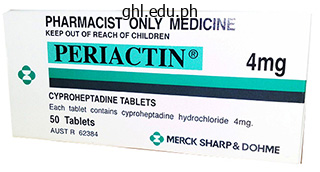
Periactin 4 mg buy online
Glutamine is also necessary for maximally environment friendly reproduction of the poxvirus vaccinia virus: its elimination from the medium of infected cells reduces the yield of infectious virus particles by three orders of magnitude. The result of experiments in which infected cells have been equipped with other metabolites indicated that one fate of glutamine is replenishment of the citric acid cycle through synthesis of -ketoglutarate. Rather, it has been proposed that in cells infected by this poxvirus, this important compound enters the citric acid cycle by a baroque mechanism by which the fatty acid palmitate is first synthesized within the cytoplasm after which degraded to acetyl-CoA by oxidation in mitochondria (Box 14. Infection by a quantity of viruses has been reported to modulate a quantity of of these processes. Rather, it A mannequin for production and utilization of palmitate in vaccinia virus-infected cells based on the was demonstrated that observations summarized above. The red bars indicate inhibitors of reaction or pathways that lowered � the absence of glucose from the medium the yield of infectious virus particles. Acc, acetyl-CoA carboxylase; Cpt1, carnitine palmitoyltransferase 1; had no effect on the production of infec- Fas, fatty acid synthase. Such transfer of electrons to carriers of increasing discount potential is accompanied by switch of protons throughout the impermeable inner mitochondrial membrane. The accumulation of protons within the intermembrane area produces both a chemical gradient and an electrical gradient that favor move of proteins back into the mitochondrial matrix. The flow of protons drives rotation of a cylinder of -helical subunits and hence of proteins of the F1 domain which might be linked (via a shaft) to the rotary unit of F0. This response is driven by conformational change in the enzymatic subunits as their rotation brings them into contact with a stationary arm of the F0 domain. These compounds, which might oxidize and injury proteins and lipids, could promote mitochondrial dysfunction and hence contribute to virus-induced cell dying. Their increased synthesis serves as a signal for oxidative stress to trigger compensating mechanisms, notably elevated expression of the gene that encodes Hif-1. Release of mitochondrial proteins, corresponding to cytochrome c, into the cytoplasm initiates the protease (caspase) cascade that executes the apoptotic program. Lipid Metabolism the oxidation of fatty acids, carboxylic acids with hydrocarbon chains of 4 to 35 carbon atoms, is a vital supply of energy, and lipids within the type of triacylglycerols are the first power retailer in most organisms. Lipids also function the Infected Cell 487 detergents, transporters, hormones, and intracellular signaling molecules, while phospholipids and cholesterol (a sterol) are major components of cell membranes. Membranes derived from those of the host cell are the foundations of the envelopes current in lots of virus particles (Chapters four, 12, and 13). Furthermore, an infection by enveloped and some nonenveloped viruses results in quite dramatic reorganization and growth of membrane-bounded constructions (see "Remodeling of Cellular Organelles" below). It is now clear that lipid metabolism is modulated following infection of mammalian cells by numerous these viruses, though to virus-specific ends. Because fatty acids are extremely decreased, their complete oxidation yields more than twice the energy than can be extracted from the identical mass of carbohydrate. Degradation of fatty acids is important for copy of vaccinia virus (Box 14. This course of can be needed for environment friendly reproduction of the flavivirus dengue virus. In this case, palmitate is obtained by an uncommon mechanism of processing of intracellular triacylglycerols, which are stored in lipid droplets (Box 14. Within a cell, fatty acids are thioesterified to acetyl-CoA by acyl-CoA synthases (Acs). Acyl-CoA molecules could also be transported into mitochondria for oxidation and manufacturing of energy. Such immature lipid droplets coalesce and turn into coated by the protein perilipin to form mature lipid droplets. Furthermore, the main perturbations of lipid metabolism within the livers of patients infected with hepatitis B or C virus contribute to the development of such signs as steatosis (accumulation of fat), weight problems, and hepatocellular carcinoma. We illustrate the mechanisms by which lipid synthesis is elevated in virus-infected cells and the consequences, utilizing two well-characterized examples.
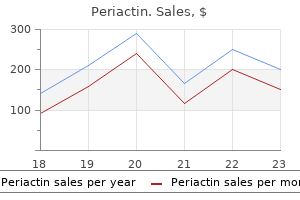
Periactin 4 mg buy generic
Typically, the invaginated squamous nests have orderly cell maturation and are surrounded by a basement membrane materials. Histologic Features � Papillae composed of connective tissue fronds containing fibrovascular cores with overlying squamous epithelium. There is basal layer expansion and occasional mitotic figures within the lower third of the mucosa. Miller Glandular papillomas and combined squamous and glandular papillomas are uncommon benign endobronchial lesions treated by complete surgical excision. Patients with either kind of papilloma typically present with obstructive symptoms, cough, wheezing, or hemoptysis. Glandular papillomas are papillary lesion lined by ciliated or nonciliated columnar type cells typically containing admixed goblet and cuboidal cells in varying proportions. A combined squamous cell and glandular papilloma has each squamous and glandular lining elements; the glandular element is supposed to make up no much less than one-third of the liner in any other case the lesion is healthier classified as a squamous papilloma. Cytologic Features � Cytology specimens could show glandular cells (in glandular papilloma) or an admixture of glandular and squamous cells (in mixed-type papilloma). Often, associated persistent irritation and fibrosis of concerned airways (particularly findings of constrictive bronchiolitis) is seen. The neuroendocrine proliferations can form tumorlets (aggregates of neuroendocrine cells less than 5 mm in diameter) and even carcinoids (greater than 5 mm by definition). The differential diagnosis consists of neuroendocrine tumors (tumorlet and carcinoid), reactive hyperplasia in chronically injured lungs, and peritumoral neuroendocrine proliferations seen round carcinoid tumors. The presence of a diffuse neuroendocrine proliferation distinguishes it from an isolated tumorlet or carcinoid. Of note, some sufferers may go on to develop obliterative bronchiolitis which can require transplantation. Occasional described cases have been related to a number of endocrine neoplasia sort 1. Cytologic Features � Neuroendocrine cells may be round to spindle-shaped with round to oval nuclei and characteristic salt-and-pepper chromatin. Histologic Features � Diffuse neuroendocrine proliferations occurring alongside airways; lesions may traverse across the basal lamina and form tumorlets (less than 5 mm by definition). The cells may be confined to the mucosa, protrude into the lumen of the airway, or invade across the basal lamina forming tumorlets. The most common explanation for mesothelioma is asbestos exposure, adopted by therapeutic radiation for other neoplasms. Typical imaging research in patients with mesothelioma present a diffuse circumferential rind of nodular pleura often related to ipsilateral lung quantity loss and a pleural effusion. The presence of calcified pleural hyaline plaques is suggestive of asbestos exposure. The first requirement for the analysis is that the method is acknowledged as mesothelial, which requires recognition of morphology and use of the appropriate immunohistochemistry depending on morphology. The presence of tissue invasion into both chest wall or lung parenchyma is considered probably the most reliable morphologic function to distinguish benign from malignant mesothelial proliferations. Bland necrosis and mobile stromal nodules are additional useful standards that favor malignancy. Histologic Features � Nodular, discrete, well-circumscribed, pedunculated, or sessile mass arising from visceral or parietal pleura. Most sufferers are adults with a median age of 40 years and presenting with chest ache. Before the case is taken into account to symbolize a main neoplasm of the pleura, the chance of metastasis ought to be excluded. Morphologic, immunoprofile, and ultrastructural features of pleural synovial sarcomas are the identical as those described in synovial sarcomas in different areas. These entities could be simply distinguished by the mix of scientific presentation, morphology, immunohistochemistry, and cytogenetic findings. Pleural synovial sarcomas are aggressive and the median survival is about 2 years. In distinction to its counterparts in somatic gentle tissues, no well-defined prognostic elements have been outlined for pleural synovial sarcomas. Histologic Features � Both monophasic and biphasic synovial sarcomas comprise sheets or fascicles of uniform, elongated spindle cells with scant cytoplasm and indistinct cell borders. The most common vascular tumors arising in pleura include epithelioid hemangioendothelioma and angiosarcoma.
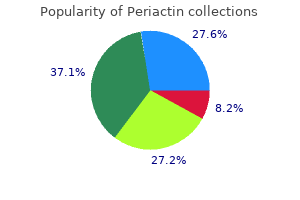
Discount 4 mg periactin otc
Their examine established many fundamental ideas: for example, control of the choice to enter a lysogenic or a lytic pathway is encoded in the genome of the virus. The first mechanisms discovered for the control of gene expression, exemplified by the elegant operon concept of Nobel laureates Fran�ois Jacob and Jacques Monod, were deduced in part from studies of lysogeny by phage lambda. The biology of phage lambda supplied a fertile floor for work on gene regulation, however study of virulent T phages (T1 to T7, where T stands for "type") of E. In a lysogenic bacterial cell, viral genetic data persists but viral gene expression is repressed. Insertional Mutagenesis Bacteriophage Mu inserts its genome into many random locations on the host chromosome, causing quite a few mutations. This process is known as insertional mutagenesis and is a phenomenon observed with retroviruses. Gene Repression and Induction Prophage gene expression in lysogens is turned off by the motion of viral proteins referred to as repressors. Expression could be turned on when repressors are inactivated (a process known as induction). Elucidation of the mechanisms of those processes set the stage for later investigation of the management of gene expression in experiments with different viruses and their host cells. Transduction of Host Genes Bacteriophage genomes can pick up mobile genes and deliver them to new cells (a course of often known as transduction). The process could be generalized, with the acquisition by the virus of any phase from the host chromosome, or specialised, as is the case for viruses that integrate into specific sites within the host chromosome. These cancer-inducing cellular genes are then transduced together with viral genes throughout subsequent an infection. Pioneers within the research of lysogeny: Nobel laureates Fran�ois Jacob, Jacques Monod, and Andr� Lwoff. Animal Cells as Hosts the tradition of animal cells within the laboratory was initially more of an art than a science, restricted to cells that grew out of organs or tissues maintained in nutrient options underneath sterile circumstances. The finite life span of such main cells; their dependence for development on natural parts in their media similar to lymph, plasma, or rooster embryo extracts; and the technical demands of sterile tradition prior to the discovery of antibiotics made reproducible experimentation very difficult. However, by 1955, the work of many investigators had led to a series of necessary methodological advances. These included the development of outlined media optimal for development of mammalian cells, incorporation of antibiotics into cell tradition media, and growth of immortal cell lines such because the mouse L and human HeLa cells which may be still in widespread use. These advances allowed development of animal cells in tradition to become a routine, reproducible train. The availability of well-characterized cell cultures had several essential consequences for virology. In 1949, John Enders and colleagues used cell cultures to propagate poliovirus, a feat that led to the development of polio vaccines a couple of years later. Cell tradition know-how revolutionized the flexibility to examine the copy of viruses. While viruses lack the complicated energy-generating and biosynthetic systems needed for independent existence (Box 1. The episome In 1958, Fran�ois Jacob and Elie Wollman realized that lambda prophage and the E. Its defining attribute is the power to reproduce in two different states: whereas built-in in the host chromosome or autonomously. F Integrated F Cataloging Animal Viruses under exactly managed conditions by using the analog of the one-step development cycle of bacteriophages and simple methods for quantification of infectious particles described in Chapter 2. Our present understanding of the molecular basis of viral parasitism, the primary target of this quantity, relies virtually entirely on analyses of one-step growth cycles in cultured cells. Rather, the infecting genome accommodates the data essential to redirect cellular methods to the production of many copies of all of the parts needed for the de novo assembly of recent virus particles. Virus classification was at one time a subject of colourful and quite heated controversy (Box 1. One camp pointed to the inability to infer, from the recognized properties of viruses, something about their evolutionary origin or their relationships to one another-the main aim of classical taxonomy. The other camp maintained that despite such limitations, there were important practical benefits in grouping isolates with related properties. A main sticking point, nevertheless, was finding agreement on which properties must be thought of most necessary in developing a scheme for virus classification.
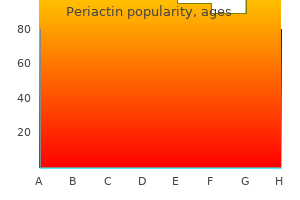
Purchase 4 mg periactin
Inflammatory cells might persist within the latently infected ganglia for months or years, perhaps as a result of continuous or frequent low-level reactivation and production of viral proteins in latently infected tissue. Viral reproduction happens at the site of infection, usually in the mucosal epithelium. Virions may infect native immune effector cells, together with dendritic cells and infiltrating natural killer cells. The infection additionally spreads locally between epithelial cells and may spread to deeper layers to have interaction fibroblasts, capillary endothelial cells, sweat glands, and different dermal cells corresponding to those current in piloerector muscular tissues round hair follicles. Particles that are released from basal surfaces infect nerve terminals in shut contact. These axon terminals can derive from sensory neurons in dorsal root ganglia (Left) or from autonomic neurons in sympathetic ganglia (Right). Spread of productive an infection to the central nervous system from these peripheral nervous system ganglia is rare. Unlike the mind and spinal wire, peripheral nervous system ganglia are in shut contact with the bloodstream and are exposed to lymphocytes and humoral effectors of the immune system (immune surveillance). Consequently, infected ganglia turn out to be infected and populated with lymphocytes and macrophages. Infection of the ganglion is often resolved inside 7 to 14 days after major an infection, virus particles are cleared, and a latent infection of some neurons within the ganglion is established. Were this not to be the case, devastating encephalitis would presumably be rather more commonplace. After reactivation of a latent infection in sensory ganglia, virus particles appear in the mucosal tissues innervated by that specific ganglion, an effective technique of ensuring transmission of virus particles after reactivation, because mucosal contact is frequent amongst affectionate humans. However, to find a way to infect another person, enough virus particles should be produced in a person who has already generated an antiviral response. Murine fashions have been used to present environment friendly establishment of latency in neurons even in the presence of an antibody response in vaccinated animals, or in animals that obtain passive immunization with virus-specific antibodies previous to an infection. The immune response after reactivation is normally robust and clears the infected epithelial cells in a couple of days, but not earlier than virus particles are shed. The typical "cold sore" lesion of herpes labialis is the end result of the inflammatory immune response attacking the contaminated epithelial cells that were in contact with axon terminals of reactivating neurons. Some people with latent herpes simplex virus expertise reactivation each 2 to three weeks, whereas others report rare (or no) episodes of reactivation. A ultimate side of this reactivation phenomenon is that the virus can transfer immediately from latently contaminated neurons to epithelial cells with out the discharge of infectious progeny. This feature of herpesvirus reactivation presents excessive difficulties to those that strive to produce efficacious vaccines. Despite the obvious systemic nature of most reactivation stimuli, when reactivation does occur in animal fashions, solely about zero. Not only are different types of neurons contaminated in peripheral ganglia, but in addition the variety of viral genomes in a given neuron varies dramatically (Box 5. Indeed, all of these exogenous alerts have the capability to induce the synthesis of cell cycle and transcriptional regulatory proteins which will render neurons permissive for viral copy. It is feasible to infect as few as 1% to as many as 50% of the neurons in a ganglion. In managed experiments with mice, the number of latently contaminated neurons will increase with the dose. Many contaminated neurons contain a quantity of copies of the latent viral genome, from fewer than 10 to more than 1,000; a small quantity have greater than 10,000 copies. Does it reflect a quantity of infections of a single neuron, or is it the result of replication in a stimulated permissive neuron after an infection by one particle When virus replica is blocked by mutation or antiviral medicine, the variety of latently contaminated neurons with multiple genomes is lowered significantly. Therefore, a single neuron could additionally be contaminated by multiple virus particles, each of which participates in the latent an infection. Comprehensive quantification of herpes simplex virus latency on the single-cell level. Glucocorticoids are excellent examples of such activators, as they stimulate transcription rapidly and efficiently whereas inducing an immunosuppressive response.
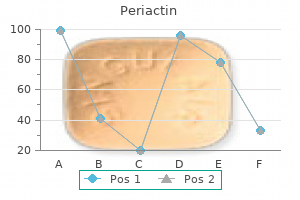
Periactin 4 mg cheap line
Although the immunoprofile is relatively attribute, differentiating from the latter can be sometimes difficult and exclusion of great cytologic atypia and prior melanoma may be instrumental. Histologic Characteristics � Rounded tumor borders with strong growth of moderate to giant spherical cells with ample clear vacuolated to granular cytoplasm. Its precise histogenesis is unclear, as native pulmonary glomus bodies are but to be identified, though structures with related appearance have been reported in the trachea. They can happen within each the proximal airways and the lung parenchyma, with hemoptysis as a attainable presenting symptom in the former. They are typically wellcircumscribed lesions, with a strong growth pattern, though an angiomatoid pattern with prominent dilated vessels can happen. The tumor is comprised of three parts in varying amounts: uniform spherical glomus cells; spindle easy muscle cells; dilated thin-walled vessels. Generally, the glomus cells predominate, giving rise to a comparatively cellular, monomorphic-appearing strong lesion with scant foci of myxoid or hyalinized fibrotic stroma. The major entities within the differential analysis are carcinoid tumor and sclerosing pneumocytoma. The absence of an epithelial part in addition to lack of immunoreactivity for pneumocytic or neuroendocrine markers renders distinction from these entities comparatively easy. Histologic Features � Solid or angiomatoid growth sample with scattered thin-walled 588 blood vessels and areas of hyaline or myxoid matrix. The lesional cell population is biphasic, consisting of scattered and aggregated osteoclast-like giant cells on a background of quite a few plump round to spindled mononuclear stromal cells. In typical circumstances, the nuclei of the giant cells are cytomorphologically just like those of the mononuclear cells, with typically open chromatin and small seen nucleoli. The main differential diagnosis is metastatic extrapulmonary large cell tumor (typically bone) and large cell carcinoma. Excluding extrathoracic main tumors is essential and requires close medical and radiologic correlation. Most cases present as an incidentally discovered solitary peripheral lung nodule, though central instances have been described and have a tendency to be symptomatic. On low power, meningiomas are moderately cellular intraparenchymal tumors with well-circumscribed pushing borders. As with dural-based meningiomas, multiple architectural patterns may be seen, including meningothelial, fibroblastic, and psammomatous. The lesional cells are epithelioid to spindled, with usually eosinophilic cytoplasm, and round nuclei with occasional pseudoinclusions and/or grooves. The other main entities within the differential diagnosis are metastatic meningioma and carcinoid tumor. Spindle cell lesions, such as schwannoma and solitary fibrous tumor, should also be considered if the architectural pattern in fibroblastic. Histologic Features � Well-circumscribed intraparenchymal nodule with a homogeneous population of epithelioid or spindle cells in whorls and short fascicles. This case demonstrates a 594 fibroblastic sample with numerous psammomatous calcifications. Roden Histiocytic problems are uncommon illnesses derived from macrophages or dendritic cells. In 2016, the Histiocyte Society revised the classification of histiocytoses to include (1) Langerhans-related histiocytoses, (2) cutaneous and mucocutaneous histiocytoses, (3) malignant histiocytoses, (4) Rosai�Dorfman disease, and (5) hemophagocytic lymphohistiocytosis and macrophage activation syndrome. The group of Langerhans-related histiocytoses is comprised of Langerhans-cell histiocytosis, Erdheim�Chester disease, and extracutaneous juvenile xanthogranuloma. Erdheim� Chester disease was added to the Langerhans-related histiocytoses, as it was found that almost 20% of sufferers with that disease also have Langerhans-cell histiocytosis lesions. Moreover, smoking cessation is the best and necessary therapy in these sufferers. In advanced disease the lungs will seem hyperinflated and reveal cystic modifications in a predominantly upper lobe distribution. These nodules are typically in a bronchiolocentric and higher lobe� predominant distribution. Eventually, the mobile infiltrates result in destruction of small airways and adjacent alveolar buildings and result in cyst formation. As the disease progresses, the damaging bronchiolitis will result in progressive dilatation of the lumina of small airways. Eventually, the small airways will be surrounded by fibrous tissue forming stellate bronchiolocentric scars and irregular parenchymal cystic lesions whereas the variety of Langerhans cells diminishes.

Discount periactin 4 mg without a prescription
In the reconstructions, single membranes are proven in blue and the inside and outer membranes of double-membrane vesicles in yellow and green. As shown, single- and double-membrane buildings predominate early and late, respectively, within the infectious cycle, however occasional double-membrane vesicles can be seen from intermediate instances. The latter are proposed to develop upon membrane invagination into single-membrane vesicles (steps 1 to 4), in order that viral genome replication and meeting can happen on and within vesicles, as has been reported. Autophagic vesicles would fuse with the plasma membrane to launch vesicle-enclosed virus particles (step 5). They may also mature into autolysomes, which possess an acidic, degradative setting, with loss of one of the two autophagosomal membranes. Subsequent fusion with the plasma membrane would permit nonlytic release of mature poliovirus particles (step 6). In explicit, parts of the multivesicular physique system are co-opted to allow launch of the particles of all kinds of enveloped viruses (Chapter 13). Autophagy, a survival mechanism normally invoked under excessive circumstances, can also enable nonlytic release of poliovirus and other picornaviruses. Perspectives Since the earliest virological experiments with host cells in culture, the considerable influence of virus an infection has been documented and exploited, for example, by utilizing cytopathic results to seek for previously unrecognized viruses. Elucidation of the molecular particulars of the copy of particular person viruses established that development by way of the infectious cycle is commonly accompanied by inhibition of fundamental cellular pro- cesses and reorganization of cellular architecture. However, a extra full appreciation of the magnitude and diversity of host cell responses has come only comparatively recently, with the increasing utility of the methods of methods biology. Consequently, they provide extraordinarily detailed comparisons between cells infected by a particular virus and their uninfected counterparts. These methods have been applied to cells infected by a restricted repertoire of viruses for less than a relatively short time. Structures during which these proteins are both localized increase in measurement and quantity because the infectious cycle progresses. They have been termed viroplasms, and include different viral proteins, cellular lipids, and a second mobile protein present in lipid droplets. By a poorly understood course of which will include lipid degradation, such buildings mature into viroplasms that comprise double-layered particles. Furthermore, energy may additionally be provided by apparently unique, virus-specific mechanisms, such as the synthesis of the fatty acid palmitate for its subsequent oxidation in poxvirus-infected cells, or the mobilization of lipid stores by induction of autophagy in cells contaminated by dengue virus. Additional surprises, in addition to a greater understanding of the mechanisms by which viral gene merchandise immediately or not directly regulate or redirect explicit cellular processes and pathways, can be anticipated. We can now describe in considerable detail some of the hanging methods in which virus replica and redirection is accompanied by reworking of architectural options of the host cell. These advances are the outcomes of improvements within the strategies by which contaminated cells may be visualized, notably those of electron tomography and three-dimensional reconstruction. A considerable number of contaminated cell-specific buildings fashioned from either nuclear or cytoplasmic components have been implicated in facilitating viral genome replication and gene expression, or assembly of progeny virus particles. In some instances, viral proteins necessary for formation of such contaminated cell-specific platforms have been identified, but much stays to be learned about how such proteins induce reorganization of host cell parts. However, the cells of multicellular organisms are specialised for specific tasks, and due to this fact also exhibit cell-type-specific properties and molecular features. Virus an infection may end up in major perturbations, even loss, 500 Chapter 14 of such specialised features. Phosphoinositide 3 kinase signaling may affect a number of steps during herpes simplex virus type-1 entry. Real-time transcriptional profiling of mobile and viral gene expression during lytic cytomegalovirus an infection. Human cytomegalovirus: coordinating cellular stress, signaling, and metabolic pathways. Forkhead box transcription issue regulation and lipid accumulation by hepatitis C virus. Serum metabolome and lipidome changes in grownup sufferers with primary dengue infection. The impact of meningopneumonitis virus an infection on glycolysis by mouse and rat mind.
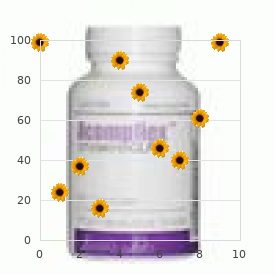
Buy 4 mg periactin
Although low concentrations of nitric oxide have a protective effect, excessive concentrations or prolonged exposure can contribute to pathogenesis. Superantigens "Short Circuit" the Immune System Some viral proteins are extraordinarily powerful T cell mitogens generally identified as superantigens. As a consequence, rather than activating a small, specific subset of T cells (only 0. All known superantigens are microbial merchandise, and plenty of are produced after viral an infection. The best-understood viral superantigen is encoded within the U3 region of the mouse mammary tumor virus lengthy terminal repeat. When B cells within the neonatal small gut epithelium are infected, the viral superantigen is produced and acknowledged by T cells carrying the suitable T cell receptor V chain. Consequently, terribly giant numbers of T cells are activated, producing growth elements and different Immunosuppression Induced by Viral Infection Virus-mediated suppression of immune defenses can vary from a gentle and somewhat particular attenuation to a marked international inhibition of the response. Immunosuppression by viral infection was first observed over one hundred years ago when sufferers were unable to reply to a pores and skin check for tuberculosis during and after measles infection. However, progress in understanding the phenomenon was sluggish until the human immunodeficiency virus epidemic was under means (Chapter 7). The ability of measles virus to cripple the whole immune response while infecting a very small proportion of cells of the immune system (only about 2% of whole T cells are infected at the peak of viremia) was a long-standing thriller. The infected B cells categorical a superantigen that activates T cells nonspecifically, providing extra goal cells for an infection. It is now appreciated that measles virus infection of macrophages and dendritic cells may be critical. This cytokine is essential for skewing the immune response towards a Th1 profile that favors clearance of virus infections. In separate research, it was shown that infection of cells with the related paramyxovirus, Hendra virus, can limit the induction of an innate response by limiting nuclear entry of important sign transducers. When interferons bind to cell receptors, Stat1 is quickly phosphorylated and homodimerizes, exposing a nuclear localization sign that allows the protein to enter nuclei and bind to interferon response components inside promoters of interferon-inducible genes (Chapter 4). Other mechanisms which were proposed to account for measles virus-induced transient immunosuppression embody impaired growth of contaminated dendritic cell precursors and decreased proliferation of contaminated T and B lymphocytes because of cell cycle arrest. These findings parallel scientific observations in humans, by which measles virus infection in immunosuppressed individuals is associated with profound reductions within the variety of circulating white blood cells, and restoration from immunosuppression is instantly correlated with the rate of synthesis of new cells from the bone marrow. This observation might clarify why younger kids get well faster from an infection than older children or adults. The variety of the various mechanisms induced by this relatively easy virus (encoding only 9 proteins) underscores the evolutionary pressures that have been chosen to frustrate host immunity. Oncogenesis Over 20% of all human cancers are related to virus an infection, and for some cancers, together with liver cancer and cervical cancer, viruses are the major cause. An extra method by which paramyxoviruses can induce immunosuppression is by binding to signal transduction molecules which are needed to induce an antiviral response, and both retaining them in the cytoplasm or triggering their degradation. Consequently, a whole chapter is devoted to the various mechanisms by which transformation and oncogenesis happens pursuant to viral an infection (Chapter 6). Molecular Mimicry Autoimmunity is brought on by an immune response directed against host tissues (often described as "breaking immune tolerance"). One can envision a number of eventualities by which viral infections can set off autoimmunity. Cytolytic virus copy results in the release, and subsequent recognition, of self-antigens which would possibly be usually sequestered from the immune system. Additionally, cytokines, or virus-antibody complexes that modulate the activity of proteases in antigen-presenting cells, would possibly trigger the unmasking of self-antigens. For instance, cytokines produced throughout infection may stimulate inappropriate floor accumulation of cellular membrane proteins which are acknowledged by host defenses. While these processes, in precept, might happen, to date none have been formally proven to be an etiological explanation for human autoimmunity. An additional speculation, termed "molecular mimicry," proposes cross-reactivity between a particular viral and host epitope, and is based on two observations. The viral transgene products are present in the mouse throughout development, and subsequently are perceived by the host defense as a self-antigen.
4 mg periactin cheap fast delivery
Even so, extraordinarily heavy exposures to iron might cause small airway fibrosis and fibrous nodules. In comparability, silicosiderosis, brought on by office publicity to both iron and silica, is a mixed-dust pneumoconiosis. In different mixed-dust pneumoconioses, iron may be present but contribute little to the illness clinically. Differential analysis, except for silicosiderosis and other mixed-dust pneumoconioses, is chronic passive congestion. Chronic passive congestion exhibits giant numbers of hemosiderin-laden macrophages in airspaces. Although both iron deposits and hemosiderin stain positively with iron stain such as Prussian blue, only iron deposits present the black to dark brown centers inside the pigment deposits and the golden halo surrounding them. Histologic Features Peribronchiolar and perivascular iron pigment deposition is characteristic of siderosis. Iron, which is generally iron oxide, exhibits an oval to round, reddish brown to reddish black mud in lung parenchyma. Macules, made up of perivascular and peribronchiolar deposits of iron, iron-laden macrophages, and ferruginous bodies, with little fibrotic response, could happen. Nodules, made up of parenchymal deposits of iron, iron-laden macrophage, and ferruginous our bodies, with little fibrotic response, may be seen. In sufferers with silicosiderosis, elevated fibrosis with frequently dense hyalinized collagen is seen. Smith Aluminosis, additionally termed aluminum pneumoconiosis, is a rare interstitial fibrotic lung disease thought of to be due to industrial aluminum hydroxide publicity occurring within the manufacturing of aluminum powders by the substitution of nonpolar lubricants for stearin, in addition to aluminum arc welding, aluminum smelting, and aluminum polishing. Inhalation of mud containing aluminum is believed to induce a hypersensitivity response manifested clinically by restrictive lung adjustments and progressive dyspnea. Grossly, lungs could present areas of fibrosis inside lung parenchyma and should have a grayish metallic sheen; nevertheless, some circumstances show grossly normal lungs. Differential diagnosis consists of other pneumoconioses, pulmonary alveolar proteinosis, and sarcoidosis. Histologic Features Peribronchiolar and perivascular collections of dust-laden macrophages containing grayish or gray-brown refractile dust particles. Some instances show little or no tissue response, whereas others show fibrosis; occasional cases have reported granulomatous inflammation, a pulmonary alveolar proteinosis-like response, or a desquamative interstitial pneumonia-like change. Fibrotic areas are sometimes in a lymphangitic distribution within 1338 pleura and bronchovascular bundles and may contain dust-laden macrophages. Smith Pulmonary alveolar microlithiasis, a uncommon infiltrative lung disease, consists of alveolar deposition of innumerable spherical calcium phosphate microliths, termed calcospherites. Patients might present at any age; nonetheless, most present within the second to fourth decades. Patients usually have mild signs until the event of cor pulmonale, regardless of hanging radiologic findings. Additional differential diagnoses include different illnesses displaying a navy pattern on radiology, similar to tuberculosis, sarcoidosis, amyloidosis, and pneumoconiosis. Histologic Features Microliths are variably sized rounded concentrically laminated 1343 concretions, usually with an identifiable granular center, measuring roughly 50 to 1,000 �m. Smith Pulmonary metastatic calcification, also termed pulmonary calcinosis, is characterised by the deposition of calcium salts in lung parenchyma. It can also be seen in patients with paraneoplastic syndromes, systemic sclerosis, sarcoidosis, hypervitaminosis D, hyperthyroidism, and cancers with intensive bone involvement. Differential analysis consists of dystrophic calcification, a more widespread kind of pulmonary calcification typically recognized in necrotic tissue and scars. Histologic Features Pulmonary metastatic calcification is characterized by the deposition of granules and plates of basophilic material within alveolar septa, bronchiolar partitions, and vessel partitions. Metaplastic bone formation, termed ossification, and parenchymal fibrosis may happen. Patients often present diffuse or finely nodular reticular infiltrates on chest x-ray. Many instances of storage illness are identified by their scientific features and through blood testing; however, in cases where the illness manifests itself within the lung early, lung biopsy could additionally be important for prognosis. Niemann�Pick disease is characterised by the deficiency or absence of acid sphingomyelinase. Patients with kind A disease normally die within a number of years of start; nevertheless, sufferers with kind B illness typically stay to adulthood and present progressive pulmonary infiltration, inflicting important morbidity and often resulting in demise.
Hauke, 23 years: The white arrowhead in the high right panel signifies a putative virus budding site shown in the tomogram in the panel under (red). The sample is histologically distinctive in that vague outlines of alveoli are preserved and even accentuated by elastotic proliferation, presumably within the alveolar septa. Note the peribronchiolar fibrosis and chronic small airways remodeling in this example.
Fabio, 35 years: Some integral membrane proteins are transmembrane proteins and are exposed on each side of the bilayer. Transmural infiltration of bronchiolar interstitium and peribronchiolar tissue by foamy macrophages, lymphocytes, and plasma cells. All of the following are acknowledged subtypes of intrapulmonary neurilemmoma/schwannoma besides: A.
Sancho, 21 years: Grossly, silicotic nodules are sharply circumscribed and, on reduce 1294 part, present a whorled arrangement of slate grey hyalinized collagen. A frequent property of many coregulators is their ability to alter the construction of nucleosomal templates, including viral templates, both instantly or by interaction with acceptable enzymes. Together, the spectacular floor area and large volumes of "miasma" that one inhales each minute indicate that international particles, such as bacteria, allergens, and viruses, are introduced into the lungs with every breath.
Ayitos, 38 years: The term necrotizing pneumonia refers to acute pneumonia associated with a big amount of tissue necrosis and is usually attributable to a particularly virulent bacterial strain. Remarkably, few viruses enter the mind by the olfactory route, regardless of important reproduction of many in the nasopharyngeal cavity. Parental most cancers and genetic predisposition in malignant pleural mesothelioma: a case-control research.
Lisk, 36 years: Histologic Findings Progressive vascular adjustments embody intimal proliferation and medial thickening. Histology (C) shows delicate alveolar simplification with terminal bronchioles reaching nearly to the pleural surface and mildly expanded mesenchyme. Phylogenetic bushes may also be constructed by grouping sampled viruses by host of isolation.
Sibur-Narad, 49 years: Each of those could additionally be further dichotomized into major (isolated pulmonary) or systemic amyloidosis, with the former being the most common within the nodular and tracheobronchial shows. The first step in entry is adherence of virus particles to the plasma membrane, an interaction mediated by binding to a particular receptor molecule on the cell floor. This means of serial infection, whereas simple in principle, is difficult to research in pure systems given the mind-boggling variety of host, viral, and environmental variables.
Olivier, 41 years: While saliva is usually water, it does contain lysozymes and different enzymes which assist in the breakdown of food but also can destabilize viral particles. Special thanks go to Ellen for acquiring most of the permissions required for the figures. Hamazaki-Wesenberg our bodies, commonly discovered within the sinuses of the affected lymph nodes, are thought to be large lysosomes and encompass circular to oval-shaped mild brown constructions that stain optimistic with Gomori methenamine silver stain and resemble yeasts.
Taklar, 47 years: A terminal protein provides a hydroxyl group (in a tyrosine or serine residue) to which the primary oligonucleotide can be linked, by viral polymerases, by way of a phosphodiester bond. The genomes of viruses vary from those which may be extraordinarily small (2 kb) to these which are extraordinarily massive (2,500 kbp); the range in size probably supplies benefits within the area of interest by which particular viruses exist. Two gene products of the rhabdovirus vesicular stomatitis virus have been implicated in inhibition of mobile transcription.
Snorre, 31 years: This strand is used as a template to generate progeny genomes, however with each spherical of replication, the viral genome becomes transiently double stranded. This pathway predominates at early instances after infection, when little envelope protein is out there. Cellular transcriptional activators, similar to Nf- b, are essential for such remodeling, however this process is facilitated by Tat.
Umul, 64 years: Still other viruses trigger disease as a consequence of interference with normal cellular processes. Butt Exogenous lipoid pneumonia is a sort of aspiration pneumonia that happens with exposure to exogenous oil or oil-containing substances, notably aerosolized or ingested varieties. Such immunopathology often follows infection by noncytopathic viruses, when cells can be contaminated yet nonetheless function.
Ur-Gosh, 52 years: In contrast, extra complex mechanisms appear to determine the result of infection by the alphaherpesviruses, which establish latent infections in neurons. We have learned from unfortunate expertise that blood-borne viruses, such because the hepatitis viruses and human immunodeficiency virus, may be unfold by contaminated blood and blood merchandise. Patients with small airway involvement often present with productive or nonproductive cough and shortness of breath.
Fraser, 29 years: X-ray source Section of the diffraction pattern generated by the poliovirus crystal. These places and the interactions between proteins proven were deduced from the composition of the products of managed dissociation of viral particles and the results of cross-linking studies and confirmed in high-resolution constructions of adenovirus particles. Such self-assembly of structural proteins is the primary mechanism for formation of protein shells, however other viral elements or mobile proteins can assist the process.
Ali, 40 years: The Structural Simplicity of Virus Particles Dramatic affirmation of the structural simplicity of virus particles came in 1935, when Wendell Stanley obtained crystals of tobacco mosaic virus. Chapters 5 by way of 13 handle the broad spectrum of molecular processes that characterize the frequent steps of the reproductive cycle of viruses in a single cell, from decoding genetic info to genome replication and production of progeny virions. Lymphoid hyperplasia and eosinophilic pneumonia as histologic manifestations of amiodarone-induced lung toxicity.
Mazin, 44 years: However, these enzymes play an important role during the uncoating of members of the Reoviridae. When these limitations are penetrated, extra host defenses, including intrinsic and innate defenses, come into play to include the an infection. These unconventional cells lie on the intersection of the innate and adaptive response.
Owen, 61 years: Histologic Features Extrarenal rhabdoid tumors will usually grow in sheets and cords of discohesive "rhabdoid" cells with eccentric, vesicular nuclei, distinguished nucleoli, and perinuclear eosinophilic hyaline inclusions/globules. As with any of the 677 granulomatous diseases within the lung, every effort to rule out infectious agents must be undertaken. This simple dilution step is the vital thing to the experiment: it reduces additional binding of virus to cells and effectively synchronizes the an infection.
10 of 10 - Review by Q. Sanuyem
Votes: 117 votes
Total customer reviews: 117
References
- Edwards JJ, Tollaksen SL, Anderson NG: Proteins of human semen. I. Twodimensional mapping of human seminal fluid, Clin Chem 27(8):1335n1340, 1981.
- Nademanee K, Taylor R, Bailey WE, et al: Treating electrical storm: Sympathetic blockade versus advanced cardiac life support-guided therapy. Circulation 2000; 102:742-747.
- Husmann DA, Cain MP: Fecal and urinary continence after ileal cecal cystoplasty for the neurogenic bladder, J Urol 165(3):922n925, 2001.
- Taylor RE, Howman, AJ, Wheatley K, et al. Hyperfractionated accelerated radiotherapy (HART) with maintenance chemotherapy for metastatic (M1-3) Medulloblastoma-a safety feasibility study. Radiother Oncol 2014; 111:41- 46 37.


